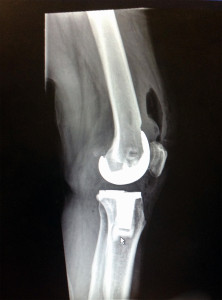Every now and then, I’m lucky enough to see one of my favourite sights in salsa: a couple in their 70s walk in to a venue and dance with so much flavour and such understated skill that they blow everyone away. The first time I saw this was about 7 years ago, and I still remember how I felt … I want that to be me when I’m an old man.
Yet life can easily get in the way. Work, family and kids usually curtail opportunities to keep dancing over time. Then there are injuries, poor health, lack of convenient venues and – possibly the biggest barrier of all – boredom.
So if you’re at the beginning of your dance journey, what are some of the things you can do to keep the fire burning and the body grooving into the future? I’ve been in love with salsa for many many years, so here are some of the things I’ve learned and that have helped keep me dancing …
1. Protect your knees
 All those turns, weight changes, spins and even rumba movements take a toll on your knees over time. I definitely know that my knees aren’t what they used to be, and chronic knee problems are some of the common injuries I hear about from long-time dancers.
All those turns, weight changes, spins and even rumba movements take a toll on your knees over time. I definitely know that my knees aren’t what they used to be, and chronic knee problems are some of the common injuries I hear about from long-time dancers.
First, if you haven’t yet invested in a pair of proper dance shoes, that is the single biggest step you can take to protect your knees. Salsa involves lots of torsion on the knees, and if you’re turning in shoes with a lot of grip, like trainers, your knees will come under a lot of strain. Reducing the friction between your feet and the floor reduces that stress significantly.
Try to adjust your dancing to the surface you are dancing on. If the floor is sticky from spilled drinks, or if you’re dancing on a hard surface like stone or concrete, cut down on the number of turns and spins and find other ways to express yourself. Leaders, please be extra-careful about leading spins on sticky floors and, if in doubt, ask your partners if they’re comfortable spinning, even if they are accomplished spinners.
Finally, posture and body alignment can make a big difference to how much strain your muscles and joints are under (not just your knees). I found that a few pilates classes helped me feel where my posture needed work and set me on the road to fixing it.
2. Protect your ears
 Salsa clubs are loud places, and often too loud! Even DJs who are careful may be obliged by event organisers to keep the volume too high. Every time you go home from a salsa night with ringing in your ears, you are literally listening your hearing being damaged. Around 70% of people in one UK survey reported ringing in their ears at least once after a concert of club, and we salsa addicts go out often! I have definitely noticed my hearing deteriorate over my salsa life, especially when I first started DJing.
Salsa clubs are loud places, and often too loud! Even DJs who are careful may be obliged by event organisers to keep the volume too high. Every time you go home from a salsa night with ringing in your ears, you are literally listening your hearing being damaged. Around 70% of people in one UK survey reported ringing in their ears at least once after a concert of club, and we salsa addicts go out often! I have definitely noticed my hearing deteriorate over my salsa life, especially when I first started DJing.
So if you dance even moderately frequently, I really really really recommend getting a pair of musician’s earplugs, and wearing them! I use the Apline MusicSafe Pro earplugs: £15 on Amazon. They’re cheap, reusable, comfortable, discreet and come with three filters for different degrees of sound attenuation. I haven’t had ringing ears a single time since I started wearing them, so I hope to still be hearing the clave and the high notes when I’m a much wrinklier dancer than I am now!
3. Enjoy your movement
There’s so much to learn in salsa, and it’s all exciting and new at first. Leaders get a kick out of collecting more and more turn patterns and challenging their ladies, while followers might revel in pulling off that third (or fourth, or fifth) spin or styling routine.
BUT … as time goes by, two things tend to happen:
- We get older! Our joints start to creak, our muscles may ache more easily and we may not be as fit, fast or assured in our motor skills as we used to be. Those crazy moves and fast footwork we used to breeze through 5 or 10 years ago suddenly don’t feel that comfortable any more.
- Dance salsa for long enough and you eventually realise that all those cool, “complicated” moves and shines are really just a bunch of simple movements layered on top of each other. Understanding this makes it suddenly much easier to create patterns of your own but, at the same time, doing complicated moves for their own sake suddenly seems less impressive than it used to be!
So if we start to slow down over time while also realising that more and trickier moves aren’t all they’re cracked up to be, what’s left? For me, it was going back and really working on the fundamentals: the basic step, simple turns and a good connection. When really done right and with the music, the basics just feel fantastic on their own! I found I didn’t need the high of those moves any more … they became a bonus, an emphasis, an accent. One of my favourite salsa instructors says that your best-looking ‘move’ should be your basic step. I would go one further: your basic step should be the ‘move’ that feels the best to you. If you can get there, then salsa will always feel good, no matter how simple or complicated we make it or how old and tired we are. After all, if you enjoy salsa so much, what’s the rush?
Having said that, who says you’ve got to slow down? Not this dude …
4. Discover cha cha
This really follows on from point #3. Cha cha music is every bit as rich, flavourful and fun as salsa, with the added bonus of being considerably slower on average. Even so, I’ve lost count of the number of times that good salsa dancers tell me they “can’t dance cha cha”. Whenever I hear this from a follower, I always try to persuade them to give it a chance – and they often surprise themselves by dancing it perfectly well. They’re just uncomfortable with the slow pace; they “don’t know what to do” with all that time.
Here’s the secret: you don’t ‘have to do’ anything. All you need are the absolute basics and a sense of fun, and you can have a great cha cha with anyone. With the music being so much slower, it’s often much easier to notice repeating patterns in the music that you can express. You don’t even need to have great body movement, just take your time, goof around with your partner to some notes, and enjoy your movement! You might even find that it helps you unlock new ways of improvising with your partner in salsa as well.
5. Find your reason for dancing
We each have a story for how we started salsa, and we also have a reason for why we came to love it! For some, it might be meeting and dancing with new people every week, while for others its hanging out and dancing with your tight group of long-time salsa friends every week. It could be the thrill of learning and executing complex turn patterns. Or maybe just flirting with the opposite (or same) sex. While all these are fun, there are often a couple of really key things for each of us, without which we might think twice before packing those dance shoes in the morning!
In the first throes of salsa addiction, we want to do everything: go out every night no matter where, take classes from several instructors at once, go to dozens of congresses, join performance teams, buy instructional DVDs etc… It can be easy to lose sight of the things we love most about salsa. But if too much of our activity doesn’t have those key things that move us to dance, burnout and boredom won’t be far behind. So if you’re feeling a bit jaded, think about what really drives you to dance and seek out events than provide it and people who share your passion.
My own personal driver is the music. If I can dance to rich, interesting music of the kind that really moves me and in the company of others who feel the same way, I’m happy. Sure, there are many other things that contribute to the ‘perfect’ night of dancing: a good floor, air conditioning, dancing with an amazing partner etc… But I can forgive a salsa night almost anything if I like the music, and I find it hard to motivate myself to go back if the music doesn’t move me, no matter how many other great things there are about an event. After 12 years of dancing I still have a blast almost every time I go out. Long may it continue!
6. Stay healthy
This is one I need to work on myself, but it mostly goes without saying: if you look after your health and conditioning, then your body will be stronger (point #1) and you’re more likely to enjoy your movement (point #3) because you’re less tired and aching.
What are your tips for prolonging your dancing life? Leave a comment below and share them!
